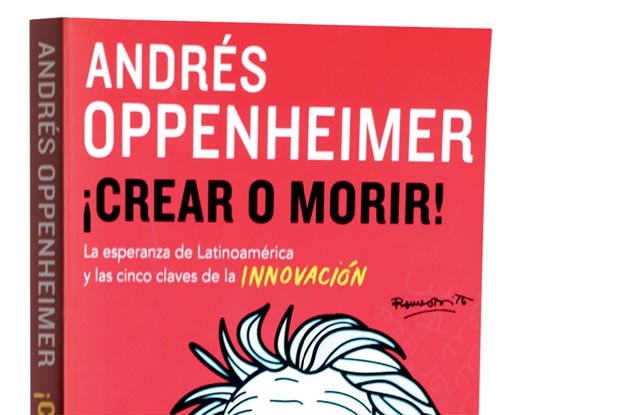Drones that deliver pizzas, 3-D printers that produce shoes, and space tourism that seeks to start a colony on Mars. These are a few of the innovations under way or on the drawing board that Andrés Oppenheimer, award-winning Miami Herald columnist and author of seven books, uses to illustrate how the world is fundamentally changing— and why Latin America must catch up.
¡Crear o Morir! La esperanza de Latinoamérica y las cinco claves de la innovación (Create or Die! The Hope of Latin America and the Five Keys to Innovation) is a captivating, behind-the-scenes tour of some of the globe’s most cutting-edge entrepreneurs. Not only does it shed light on the secrets of their success, it’s a wake-up call for Latin American countries that, Oppenheimer notes, produce fewer patents per year than either South Korea or Japan.
By traditional standards, Latin America is a success story. Nearly 70 million people were lifted out of poverty in the past decade, and, according to the World Bank, income inequality fell by 10 percent between the mid-1990s and 2011. Access to education has markedly improved in what is increasingly becoming a middle-class region.
But merely riding this wave is not enough. The commodities boom, which fueled a large portion of the past decade’s growth but now seems to be winding down, will not generate economic prosperity in the decades to come.
As Oppenheimer makes clear, the region’s future will depend on ushering in a culture of innovation. While he notes that personal creativity is certainly not lacking, he argues that the primary challenges are improving the quality of, and broadening access to, education. Legal systems, he adds, should become “more tolerant of business failure” with more forgiving bankruptcy laws.
The book centers on eight innovations and the entrepreneurs behind them to illustrate that innovation flourishes when rewards exist for taking risks, and where failing can be just as important as being successful. Some innovators are well known, while others are lower profile. All provide inspiring lessons for the region.
Take Jordi Muñoz, the focus of chapter three. At age 20, in 2007, he arrived in the U.S. from Mexico without papers, employment or a university degree. His dream? To sell computers at Best Buy. By 2009, he was a cofounder of 3D Robotics—a California company that now boasts over 200 employees, 28,000 clients and more than $60 million in projected sales this year.
His rise to success started with blogging about building do-it-yourself drones. Muñoz quickly entered the community of what Oppenheimer calls “makers”—innovators who work together online to build ideas. Chris Anderson, then editor-in-chief of Wired magazine, discovered Muñoz after the young immigrant began posting to Anderson’s “Do It Yourself Drones” blog. He was immediately impressed by Muñoz’ knowledge and creativity. Soon thereafter, they formed 3D Robotics together.
But innovation is not just about technology. In chapter six, Oppenheimer highlights how the Spanish soccer player-turned-coach Josep “Pep” Guardiola revolutionized the game when he led Barcelona’s winning team from 2008 to 2012. Not content with celebrating the team’s victories, he pushed his players to think of themselves as a single playing unit rather than a collection of individuals. While some coaches only try new things when losing, Guardiola’s key to success was “innovating while winning,” writes Oppenheimer. If companies like Kodak or Compaq had followed Guardiola’s model, these former titans might still be in business today.
While the stories make fascinating reading, they sometimes obscure the critical point Oppenheimer makes about the national policy framework required to generate innovation.
In the final chapter, Oppenheimer does, however, provide five major takeaways that could serve as general policy recommendations for Latin America.
First, create a culture of innovation where there’s “collective enthusiasm for creativity” and where failure is nothing to be ashamed of. Governments should facilitate this through legislation that unlocks barriers to innovation. Second, promote education for innovation. This means teaching how to process information and foster creativity, rather than simply imparting knowledge. Third, adopt laws that foster innovation, making it easier to open a business, while respecting intellectual property, and importantly, modifying bankruptcy laws. In this, he notes the “enormous difference with the legal frameworks of countries that encourage innovation.”
The final two ingredients for the region’s success: investment in innovation and adapting an educational culture that encourages a global outlook. Oppenheimer notes that Brazil, Chile and Mexico are already working on this last goal through government-funded educational exchange programs that send young people abroad to study in some of the world’s best universities. More countries, he suggests, should follow suit.
What’s clear is that despite Latin America’s success in harnessing both public and private sectors to achieve social gains, a new approach is needed to ensure the region can compete in today’s sophisticated global markets. Innovation—and policies that foster it—can help Latin America take the next, crucial step up the ladder of social prosperity. Oppenheimer’s book, though light on precise recommendations for specific countries, is a must read for understanding the stakes. Hopefully, other writers and researchers will soon follow his lead with more concrete ideas on how to capture the region’s untapped potential.




